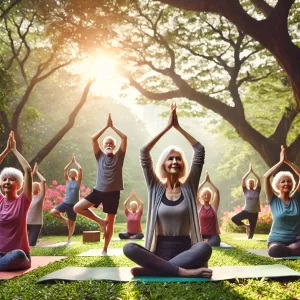
The Global Impact of Indian Yoga Gurus in 2025

In 2025, the influence of Indian yoga gurus has transcended borders, cultures, and languages, making yoga a globally revered practice. Once considered an ancient Indian tradition, yoga has now become a multi-billion-dollar wellness industry across continents, thanks largely to the tireless efforts of visionary Indian yoga masters. From physical well-being to spiritual awakening, their teachings have inspired millions to embrace yoga as a lifestyle, not just a fitness routine.
In this article, we explore the global impact of Indian yoga gurus in 2025, highlighting how they continue to transform lives, reshape wellness paradigms, and promote peace and balance in a fast-paced world.
1. The Rise of Global Wellness and India’s Leading Role
The global wellness market has surged in recent years, with yoga emerging as a key pillar. According to the Global Wellness Institute, yoga is now practiced by over 500 million people worldwide. At the heart of this movement are Indian yoga gurus, who carry the spiritual legacy of the practice while adapting it to modern lifestyles.
Their influence is evident in:
-
Online yoga platforms and mobile apps
-
International yoga retreats and teacher training programs
-
Yoga therapy for chronic diseases
-
Collaborations with global health organizations
2. Renowned Indian Yoga Gurus Making Global Impact
1. Sadhguru (Jaggi Vasudev)
Through the Isha Foundation, Sadhguru has become a household name globally. His “Inner Engineering” program is offered in over 150 countries and blends classical yoga with practical tools for mental clarity and emotional balance. In 2025, his Conscious Planet Movement and environmental efforts have drawn global attention to yoga’s connection with sustainable living.
2. Baba Ramdev
Founder of Patanjali Yogpeeth, Baba Ramdev has brought yoga into the mainstream, especially through mass media. With televised yoga sessions, herbal product lines, and global health campaigns, his teachings have reached millions across Asia, Africa, Europe, and the Americas.
3. Sri Sri Ravi Shankar
Through the Art of Living Foundation, Sri Sri Ravi Shankar has introduced yoga and meditation to over 180 countries. His emphasis on breathwork (Sudarshan Kriya) as a tool for inner peace has gained recognition even in medical communities.
4. Paramahansa Yogananda (Legacy)
Though he passed away decades ago, Yogananda’s legacy through the Self-Realization Fellowship continues to influence spiritual yoga practitioners worldwide. His book Autobiography of a Yogi remains a global bestseller and is more relevant than ever in 2025.
3. Yoga as a Holistic Health Solution
One of the most profound global contributions of Indian yoga gurus is the promotion of yoga as a holistic healing system, not just a physical exercise. In 2025, yoga is widely accepted in the West as a complementary therapy for conditions like:
-
Diabetes
-
Hypertension
-
Depression
-
Anxiety
-
Insomnia
-
Arthritis
Major hospitals and wellness clinics now offer yoga therapy sessions designed by Indian experts. Universities have introduced yoga research programs, many in collaboration with Indian institutions.
4. Digital Revolution: How Yoga Went Global from Indian Ashrams
The COVID-19 pandemic accelerated the digital transformation of yoga. By 2025, Indian yoga gurus are leading massive online communities with:
-
Virtual yoga classes streamed globally
-
AI-based yoga posture correction apps
-
Multilingual guided meditation platforms
-
YouTube channels with millions of followers
Apps like Sattva, Inner Engineering, and Patanjali Yog have grown tremendously, integrating yoga philosophy with daily wellness tools and creating accessible formats for all age groups.
5. International Yoga Day: A Global Celebration of Indian Wisdom
Thanks to India’s initiative and the support of Indian yoga masters, June 21st is now celebrated globally as International Yoga Day. In 2025, cities across the world—from New York to Nairobi, London to Lima—host mass yoga events, often led by Indian instructors or influenced by Indian traditions.
These global celebrations reinforce yoga’s roots in India while showcasing its universal appeal.
6. Yoga Tourism: India’s Global Appeal
In 2025, India is a leading destination for yoga tourism. Thousands travel annually to Rishikesh, Kerala, Mysore, and Goa to:
-
Attend yoga teacher training courses
-
Participate in meditation and detox retreats
-
Learn from traditional Indian masters
Indian yoga schools are now certified by global standards, and many Indian gurus run international centers in countries like the USA, Canada, Australia, and Germany.
7. Yoga and Spiritual Empowerment
Unlike fitness-centric yoga popular in the West, Indian yoga gurus emphasize the spiritual and ethical dimensions of yoga. The Yamas and Niyamas (moral codes), meditation (Dhyana), and devotion (Bhakti) are central to their teachings.
In 2025, there’s a growing shift in global consciousness—people are seeking purpose, peace, and inner harmony. Indian yoga gurus are guiding this journey with ancient wisdom adapted for modern seekers.
8. Yoga in Schools and Corporates: Indian Model Goes Global
India’s integration of yoga into school curriculums has inspired similar models worldwide. In 2025:
-
Many Western schools now offer morning yoga and mindfulness sessions.
-
Corporations are hiring Indian yoga experts to design wellness programs.
-
Workplace stress reduction through yoga is a booming industry.
9. The Future: Yoga as a Global Language of Well-being
The legacy of Indian yoga gurus continues to grow. With a perfect blend of ancient tradition and modern science, they are shaping yoga into a global language of health, peace, and consciousness. As technology advances, so does the reach of their teachings, making yoga more inclusive, accessible, and transformative than ever.
Conclusion
In 2025, the world stands at the crossroads of chaos and consciousness, and it is the wisdom of Indian yoga gurus that is gently nudging humanity toward the latter. Their impact is not measured just in social media followers or app downloads but in the millions of lives transformed through breath, movement, and inner awareness.
As we move forward, the teachings of these gurus remind us:
“Yoga is not just about touching your toes. It’s about touching your soul.”